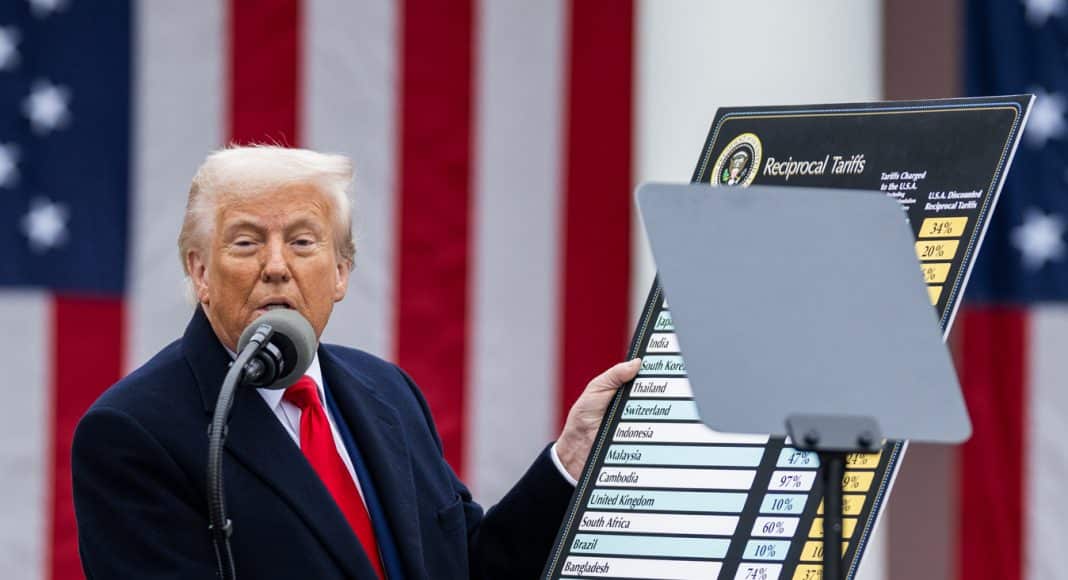President Donald Trump is recklessly trying to reverse the relative decline of US imperialism’s grip on the global economy. His methods are those of a bullying property dealer. Whole countries are treated as ‘real estate’ to be seized or bought. His threats to Panama induced the sudden purchase, by US investors, of ports at each end of the Panama Canal. He plans a ‘Compact of Free Association’ for Greenland and supplies the weapons for genocidal resident clearances in Gaza and the West Bank. Trump is forcing new trade deals and investment programmes on states around the world, and to underline this menace, he announced on 25 May that his US industrial renewal would produce ‘chips and tanks … not t-shirts and socks’. JAMES MARTIN reports.
The threats against US imperialism which Trump daily denounces are of its own making. The massive overconsumption of products outstrips US domestic productive capacity. The resulting deficit in its international goods trade reached $1.22trn in 2024 and was only partly compensated by a net services export revenue of $300bn, plus net inward flows of foreign capital of $280bn. Separately, net earnings from US foreign investments is $0.6trn, but these inflows are less than those needed to balance its total international payments. Long-term net sales of US property to non-residents have funded the current level of imports and capital exports. The present result is a negative cumulative foreign investment stock of $26trn. This is indicative of the weakening of the US ruling class’ ability to shape the world.
‘Vulnerable to geopolitical disruption’
The White House wants to revive the manufacturing past. It declared that ‘In 2023, US manufacturing output as a share of global manufacturing output was 17.4%, down from 28.4% in 2001’ … ‘From 1997 to 2024, the US lost around 5 million manufacturing jobs and experienced one of the largest drops in manufacturing employment in history’… and vitally ‘US stockpiles of military goods are too low to be compatible with US national defense interests.’ Specifically, ‘Increased reliance on foreign producers for goods has left the US supply chain vulnerable to geopolitical disruption and supply shocks’. The continued dominant global role of US finance capital and services is carefully ignored in Trump’s concern for the US visible trade deficit.
US net investment position
The US has had a cumulative net negative foreign investment position since 1980. In 2024 it absorbed 25% of global capital transfers. Foreign businesses now own more property in the US than US corporations own abroad. Inward investment accelerated after former president Biden’s Inflation Act, but the increased output of foreign investors operations has not improved the US’s export record. China, Mexico and Vietnam were the top three countries with which the US had the highest trade deficits.
Consequently, US net imports can only be financed by credits to importers or with foreign loans. The federal debt held by foreign and international investors reached $8.5trn by the end of 2024, costing $239bn annual interest payments. Total public and private interest payments to foreign entities is now $450bn per year. This has placed the US dollar in a weakening position over the last three years despite its hallowed status as a ‘safe haven’. Over the longer period, the dollar’s share of other countries’ foreign-exchange reserves fell below 53% in 2024, down from 71% in 1999. To protect the dollar, Trump has broken World Trade Organisation agreements and is forcing states across the world to renegotiate new tariff rates. At the same time, he demands that US manufacturing corporations retreat from global production sites to ‘home’ locations.
Trump’s desire to increase exports and his calls for more inward capital flows, will allow the export of more capital, the prerequisite to dominating global trade, and which provides much needed foreign profits.
The tariff game
On 1 February Trump signed executive orders imposing 25% tariffs on all goods from Mexico and Canada, most in breach of Trump’s previous USMCA (United States-Mexico-Canada Agreement) treaty of 2020. A complicated set of exchanges followed, involving US threats to Canadian sovereignty. Trump’s chauvinism provoked an electoral swing in the 28 April Canadian election against the pro-Trump candidate. Eventually most USMCA compliant goods were excluded from tariffs, but both Canada and Mexico are pursuing removal of other tariffs through the World Trade Organisation.
Except for the global 25% duties on steel and 10% on aluminium imports starting 12 March, the rapid changes in other US tariff rates, imposed, adjusted, or suspended over the first three months of Trump’s second administration, vary according to country and sector. The aim was to test other government’s responses. By the end of March, these measures had increased the US average tariff rate to approximately 12%, the highest level since World War II.
On Wednesday 2 April Trump’s theatrical ‘Liberation Day’ tariff announcement affecting more than 180 countries, included a 10% US tariff on its British imports, with a range of higher tariffs on other states, including a 20% levy on the EU. A 25% global tariff was announced on imported automobiles and automotive parts. A tussle of tariff changes between China and the US followed. By 14 May they had agreed to lower their ‘reciprocal tariff’ rates to 10%, from previous peaks of 145%. However, due to other existing duties, China’s average tariffs on US exports are currently 32.6% on all goods. Average US tariffs on Chinese exports now stand at 51.1% on all goods.
Britain’s response
The British bourgeoisie reacted rapidly to these trade threats. On 6 May Britain completed a new trade deal with India, expected to double bilateral trade by 2030. Britain has conceded more than India, to obtain cheaper inputs, phased in over a 10-year period. Then on 8 May an US-UK Economic Prosperity Deal (EPD) with no binding legal text, was eagerly agreed by both sides. Trump required some proof of success for his gambles. The British government was keen to maintain the status quo with its largest trading nation partner (18% of British trade), with which it runs a rare trade surplus. Since the US has more capital invested in Britain than Britain does in the US, and is a ‘secure’ host and vital centre for US financial and digital corporations, the US gave it priority. The agreement retains the 10% tariff on British exports, centring on quotas for British car exports and US beef and ethanol exports, but mostly promises further steps. Either side may terminate the EPD by written notice.
Trump’s tariff attack has quickened UK-EU reconciliation. On 19 May a UK-EU deal agreed institutional links on foreign, space and cyber security exchanges. Importantly, after Britain signs a third country agreement, it will participate in a €150bn loans-for-arms fund backed by the EU’s budget. EU fishing fleets access to British waters were extended, and in return the ‘vast majority’ of British agrifood exports will enter the EU without checks and certificates if Britain follows the EU’s plant and animal rules. A new youth experience scheme will be arranged but with no special deal for touring artists badly hit by Brexit.
It was agreed to explore re-linking their respective emissions trading schemes, which were severed by Brexit. If done, Britain will be exempted from the EU’s carbon border tax that comes into force on 1 January 2026, a year before Britain’s own scheme.
EU response
Impatient with talks with the EU, on 23 May Trump arrogantly threatened to put a 50% tariff on EU exports to the US on 1 June, unless European corporations agreed to move their operations to the US. The EU and US have the most integrated economic relationship in the world. The US took 20.6% of EU exports in 2024. However, since the EU takes 15.5% of US exports and had prepared its own tariff counterattack, Trump dropped his threat after two days, reverting to his previous 9 July ‘deadline’ to complete talks. The EU has counter-proposed a zero mutual tariff regime. The need to bypass US import tariff hikes has already hastened new US investment plans by some EU firms.
US centralisation of capital
The US ruling class is pushing to control, concentrate and centralise more capital at home, within a single legal jurisdiction, to secure its logistical lines, and expand the supply of skilled labour to US companies. Trump has threatened to impose tariffs on Apple and Samsung products to force their capital transfer to the US. This is wanted to improve the balance of US foreign trade payments, and to provide the extraordinary sums of capital needed to raise US productivity above its existing level. For example, huge sums of investment are required for Generative AI’s planned ‘mega-data-campuses’ with dedicated energy centres producing enough power to supply entire cities. Investments like this are necessary if US corporate competitiveness and profitability are to be sustained.
US capital imports and exports are vital for its existence but must now be made under more ‘secure’ conditions. Following Trump’s mid-May visit to Saudi Arabia, Qatar, and the United Arab Emirates, OpenAI promptly announced a push to ‘help’ other countries build AI infrastructure. Trump’s visit was to encourage these carbon fuel states to spend their oil and gas income in the US, with Saudi Arabia promising to invest $600bn in the next four years, almost doubling its current US stock of $770bn. Since Saudi Arabia will run both current trade account and fiscal deficits during 2025-28 it will not have the money to do this. Furthermore, Trump’s request to Saudi Arabia and OPEC to lower oil prices would worsen their outlook. However, Saudi Arabia is now contracted to buy $142bn US weapons as the rising Middle East guardian of imperialist interests.
Trump’s autocratic moves
Trump’s aims pursue those of the reactionary Heritage Foundation’s 2025 Presidential Transition Project, published in April 2023. His clique aims to reshape federal government by consolidating executive power. The ‘Project’ proposed a ‘unitary executive’, directly controlled by the president. To do this, Trump has declared eight national emergencies from mid-January to now, an unprecedented 21 national emergencies during his two terms. The National Emergencies Act 1976 provides more than 120 powers that presidents can use. So far, he has issued over 130 Executive Orders. To overturn a presidential national emergency order would require a currently impossible two-thirds vote in both houses of Congress. Only a thicket of judicial appeals can slow this strategy, and on 28 May the US Court of International Trade decided some of Trumps’s tariff play was illegal. US small industries brought the case to oppose the damage done to their business. Although quickly paused and awaiting appeal, Trump’s tariff play is an attack on both US workers and the middle classes and will continue to play out despite the legal game and its constitutional implications.
An aggressive foreign policy
Forcing other countries to accept tariffs that divert trade elsewhere won’t solve the fundamental problem of US indebtedness. The US has over-accumulated capital which cannot be profitably invested domestically, it therefore has no choice but to operate even more aggressively worldwide. Now, Trump’s tariffs have provoked a reaction from the US’s main trading partners which are nearly all looking to reduce the weight of their US trading partnerships. This alienation of the European, British and other ‘allied’ states is not a result of Trump’s personal idiosyncrasies, but the working out of a deepening series of inter-imperialist antagonisms. Competition for markets and resources, driven by the blind and unceasing urge to produce and realise surplus value (ie profits), inevitably leads to sharper and sharper conflicts, tragically already demonstrated by over a century of wars. Only the overthrow of the capitalist class can end this running disaster.
FIGHT RACISM! FIGHT IMPERIALISM! 306 June/July 2025




